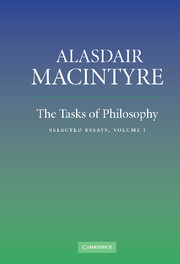Book contents
- Frontmatter
- Contents
- Preface
- Acknowledgments
- PART I DEFINING A PHILOSOPHICAL STANCE
- 1 Epistemological crises, dramatic narrative, and the philosophy of science
- 2 Colors, cultures, and practices
- 3 Moral relativism, truth, and justification
- 4 Hegel on faces and skulls
- 5 What is a human body?
- 6 Moral philosophy and contemporary social practice: what holds them apart?
- PART II THE ENDS OF PHILOSOPHICAL ENQUIRY
- Index
2 - Colors, cultures, and practices
Published online by Cambridge University Press: 05 June 2012
- Frontmatter
- Contents
- Preface
- Acknowledgments
- PART I DEFINING A PHILOSOPHICAL STANCE
- 1 Epistemological crises, dramatic narrative, and the philosophy of science
- 2 Colors, cultures, and practices
- 3 Moral relativism, truth, and justification
- 4 Hegel on faces and skulls
- 5 What is a human body?
- 6 Moral philosophy and contemporary social practice: what holds them apart?
- PART II THE ENDS OF PHILOSOPHICAL ENQUIRY
- Index
Summary
It is a remarkable fact that the truth or falsity of a judgment about what color some particular object or surface is is and is generally recognized to be independent of how that color happens to look to the particular person who utters that judgment. Someone looking at an object, who suffers from some as yet unrecognized defect of color vision, or who is looking in visually unfavorable circumstances, may have her or his false judgment about its color corrected by someone blind who has been told what color it is by a reliable informant.
Wittgenstein appears to deny this at one point in the Remarks on Colour, when he not only asserted “That it seems so (so scheint) to human beings is their criterion for its being so” , but added that only in exceptional cases might being and seeming be independent of one another. If Wittgenstein meant by this no more than that it is a necessary condition of our color judgments being as they are that, for example, “we call brown the table which under certain circumstances appears brown to the normal-sighted”, then it would be difficult to disagree. But the use of the word “criterion,” as I shall suggest later, is misleading. For the recognition of a color is not generally the application of a test.
- Type
- Chapter
- Information
- The Tasks of PhilosophySelected Essays, pp. 24 - 51Publisher: Cambridge University PressPrint publication year: 2006
- 1
- Cited by

